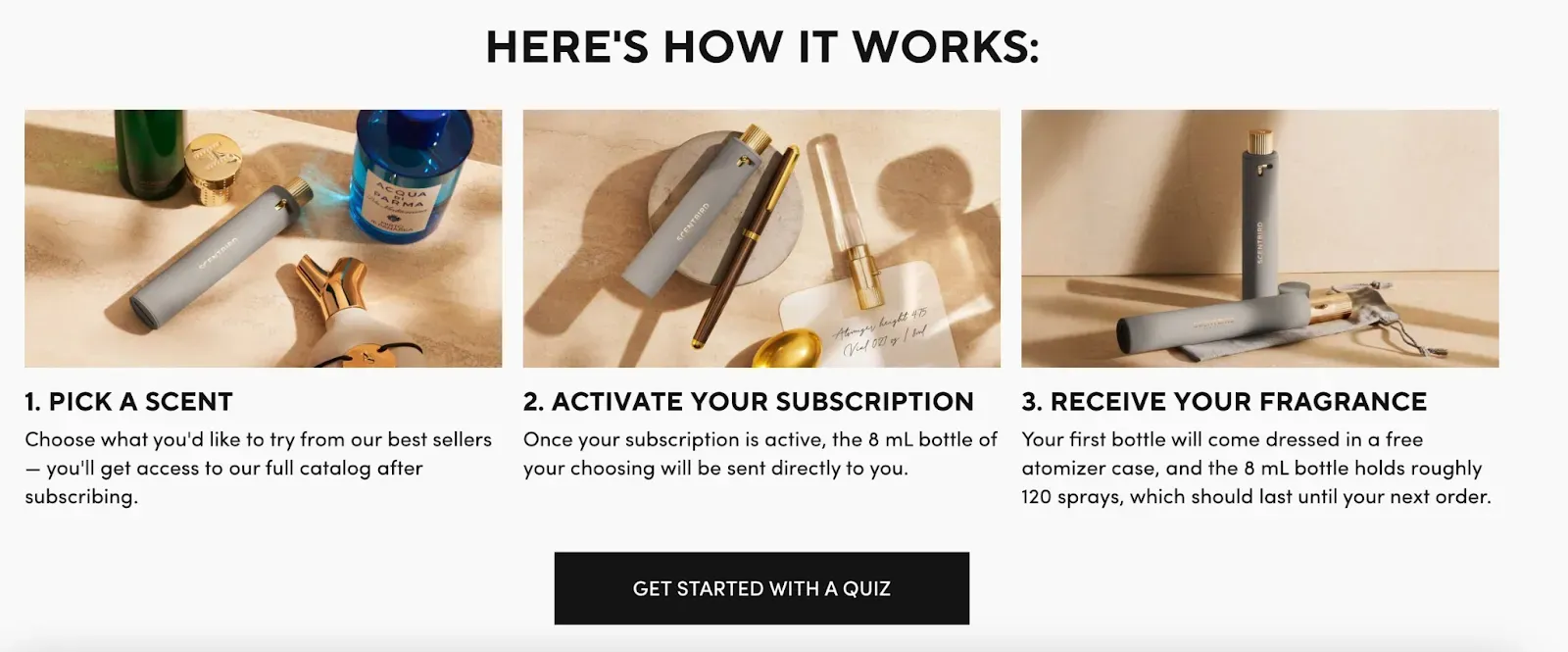
Exploring the Future Trends in Ecommerce Subscription
The world of ecommerce subscription software is evolving.
Fast.
When BirchBox (the original subscription box curator) kicked off the subscription trend in 2010, it changed the way customers interact with brands and how brands can engage customers.
Since then, it’s led to a rising demand for subscription services, and these new consumer habits are continuing to change rapidly and disrupt the market.
But the one common thread tying everything together? A customer-centric approach.
Below, we’ll look at the six biggest trends impacting consumer subscription software and how your business can leverage each one to create a thriving subscription-based business model that keeps the spotlight on your customers.
The Growth of Subscription Commerce
Ecommerce subscription is a booming industry. In one year, it grew from $72.91 billion in 2021 to a whopping $120.04 billion in 2022.
And that's just the beginning.
By 2026, it's expected to reach $904.2 billion.
What’s caused the rapid rise of ecommerce subscriptions?
It’s struck a chord with customers who value the convenience of receiving your favorite products or services without the hassle of repetitive ordering.
It’s one less thing for your to-do list, and coupled with cost savings and loyalty rewards, these benefits have led to a significant uptick in ecommerce subscription software adoption.
If there is one thing you can be sure of, it is this - ecommerce subscriptions are profitable, and there’s a high chance your audience wants to see this product from you.
The Biggest Consumer Subscription Software Trends
Want your business to catch this exciting wave? Then jump on these consumer subscription software trends ASAP.
The Rise of Subscription Boxes
The subscription model isn’t limited to a single format. Some businesses thrive with access-based subscriptions (e.g., Netflix and Disney Plus), while others rely on selling software subscriptions such as Hubspot and ClickUp.
But the one format that’s dominating the industry is subscription boxes.
Back in 2011, the market was only worth a humble $57 million, but by 2016, when game-changers like Dollar Shave Club launched, it quickly grew to a staggering $2.6 billion!
Those numbers show no signs of slowing down, with the subscription box market expected to reach $65 billion in revenue by 2027.
However, if you want to see success with this model, you can’t treat your boxes like ready-made bundles.
The key is putting the power in your customer’s hands.
Let’s look at Scentbird.
It’s a subscription box for perfume lovers. Members can pick a designer scent from the curated list with smart recommendations every month based on their preferences and past purchases.

By letting the customer choose what goes into the subscription box and adding functionality to mix and match items, it becomes more than the stuff inside the box. You’re curating a personalized shopping experience.
Using Zero-Party Data to Offer Privacy-First Personalization
That’s the perfect segway into the next trend in consumer subscription software - personalization.
Personalization is more than adding a [NAME] field to your emails. It’s about creating interactions that will make your customers feel understood by your brand.
And consumers expect it.
In the Next in Personalization 2021 Report by McKinsey, 71% of consumers expect companies to deliver a personalized experience, and 76% are frustrated when this doesn’t happen.
With store and product loyalty becoming more elusive, getting it right matters.
However, you can’t create a personalized experience without data, and consumers have become increasingly concerned about how their personal data is collected and shared.
It’s led to the phasing out of third-party cookies and zero-party data emerging as an ecommerce subscription trend.
With zero-party data, you’re collecting valuable information about your customer straight from the source. It’s more accurate and tells you exactly how the individual wants to be recognized by your brand.
Using the data, you can refine your offerings, personalize your product recommendations, and back up your marketing strategies with data-driven insights.
You’ll end up making better business decisions that resonate with your customers. Foster trust, long-term engagement, and loyalty amongst your subscribers, turning your subscription model into an unforgettable journey.
Integrating SMS Functionality
SMS functionality in your ecommerce subscription software is more than a “nice to have.” It’s a powerful tool that can increase your customer lifetime value (LTV) by 30%.
With such a game-changing statistic, you’d think everyone would use it, right?
Surprisingly, usage among merchants is still relatively low at less than 5%, but that doesn’t mean it isn’t an emerging ecommerce subscription trend.
75% of merchants with more than $5 million in gross merchandise value (GMV) utilized SMS integrations in 2021.
So, while it’s not the norm yet, that’s great news for you.
Add SMS functionality to your subscription service and give your ecommerce business a competitive edge by letting customers manage their subscription orders and deliveries from their phones.
It cuts down on customer support tickets (no more back-and-forth emails, yay!), and you can prevent any sour customer service experiences like orders arriving when no one is home.
Plus, a strong link exists between subscribers who actively manage their accounts and retention.
Creating Paid Membership Programs
Paid membership programs are rapidly gaining traction as a trend in ecommerce subscription software.
Why?
It elevates the experience for both the customer and the business.
These memberships or paid loyalty programs offer subscribers exclusive access to benefits, discounts, rewards, or early access to new products or services.
It’s a way for the brand to boost engagement and create a sense of community, further solidifying brand affinity.
That’s not a throw-away fact.
62% of customers say they are more loyal to brands with paid loyalty programs, and 67% would join a membership if it offered significant benefits.
So, what are those benefits that’ll entice users to opt in?
-
Meaningful rewards: Points are pointless. Customers want rewards that matter, like cashback and in-store credit.
-
Exclusive content access: Give paid members access to premium content like special areas of your site, early-access product drops, or discounts.
-
Limited-edition offers: Create a strong incentive to sign up for a membership with special collectibles or members-only products.
Still need some convincing?
Paid memberships are good for your bottom line. It’s an easy way to reward your superfans while creating a second recurring revenue stream for your business.
Cha-ching.
Bundling Products and Perks for Subscriptions
The next big thing in ecommerce subscription? Super bundling.
It’s a way for your business to combat subscription fatigue.
Think of it like Netflix. Instead of buying each movie or TV series individually, you’re paying a monthly fee for unlimited access to the streaming giant’s entire catalog.
Super bundling follows a similar principle. It’s a single platform with a limitless portfolio of subscriptions, all paid for in a single monthly payment.
And this is something consumers are demanding.
According to research by Bango, 78% of subscribers want a single platform for their subscriptions.
But how would this work for your ecommerce business? Instead of super bundling subscriptions, you can bundle other parts of your business to improve the customer experience and offer greater flexibility.
For example:
- Opting for a unified retention platform for your paid and earned loyalty programs.
- Using a unified branded wallet to make it easier for members to keep track of their rewards and refer you on the spot.
- Using AI to automatically bundle products and make recommendations according to user's preferences.
- Joining loyalty partnerships with like-minded brands to offer better perks and more redemption opportunities to your customers.
And you’re right.
Addressing the trend of super bundling does sound like an administrative and tool stack nightmare. How would payment work? What could the customer dashboard look like? How does data privacy fit into this?
Well, the good news is that TOKI can help you easily manage a loyalty program with other brands. Instead of bundling products, you can bundle unique perks and give members the flexibility to redeem their points across the alliance.
The built-in AI Smart Matcher automatically suggests partner alliances for your brand from a wide range of customer data. Once you’ve found a brand to collaborate with, setting up the partnership only takes three clicks.
Involving Consumers in Brand Decisions
The convenience of subscription models is driving its growth, but there is something that can hinder it.
Inflation and shrinking budgets might cause consumers to cancel their subscriptions.
The solution to ensuring your brand doesn’t get the chop?
Brand loyalty through co-creation.
Ecommerce businesses that recognize the immense value of letting members actively shape the direction of their offerings are becoming staples and not unessentials.
This trend not only creates a sense of community and loyalty but also a one-two punch for your brand - gaining valuable product feedback.
Here are some of the ways you can use co-creation to collaborate with your members:
-
Early Access and Beta Testing: Offer subscribers exclusive access to new products, features, or services before they are officially launched.
-
Co-Creation Campaigns: Invite subscribers to vote on ideas, designs, or potential offerings.
Both options are a customer-centric approach that deepens the emotional connection with your brand.
Want an example?
RAIZE, a specialty online bakery, uses TOKI’s Shopify integration to co-create with fans via the Voting Activities feature. Setting rules for its subscription tiers, customers can vote on new flavor drops for their cookies with VIP votes counting 5x the amount.
The proof is in the pudding.
RAIZE increases engagement, and can see what cookie flavors will resonate before baking a single batch, skillfully avoiding any flops.
Using AI to Mitigate Churn
Churn.
It’s inevitable.
…Or is it?
With the trend of using AI to mitigate churn, it’s becoming increasingly easier for ecommerce brands to save a customer.
Consider this: 47% of customers who left a subscription service due to overstock would have stayed if they could have paused or skipped the next delivery.
Through the power of AI, you can analyze your data to anticipate if a subscriber is at risk of churn because of overstock and take action before the customer hits the “cancel” button.
The same algorithms can also help identify other patterns and trends that may indicate potential churn—for example, flagging a decrease in engagement or lack of interaction with your brand.
But that’s not the only preemptive measure AI can help you take.
On average, merchants lose 10% of their revenue to failed payments, one of the biggest contributors to passive churn.
Ouch.
You can mitigate this risk by using an AI-failed payment recovery system.
It will automate and streamline billing cycle communication between you and the client. If a payment fails, AI will notify the customer, nudging the user to update their credit card details and attach a link to update their payment details.
How much of an impact will using AI to automate customer support have on your business?
According to Recharge Payment’s State of Subscription Commerce Report for 2022, you can potentially save $130,000 per annum.
Lastly, AI algorithms give you the ability to deliver personalized interventions to at-risk subscribers.
For example, if engagement is wavering, you can take action by automatically sending out a targeted offer, discount, or exclusive content to re-engage and retain any subscribers who might be considering cancellation.
Get on Top of Subscriber Demand
Ecommerce subscription software has ushered in a new era of consumer engagement and business growth, and these trends are a good indication of where the market is going.
By tapping into the appeal of convenience and personalization and combining it with co-creation, artificial intelligence automation, and paid memberships, you can create a customer-centric subscription model that resonates with your target audience and rewards your day ones.
Ready to embrace the future of loyalty?
Get started with TOKI for free and start maximizing your business results.